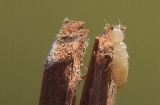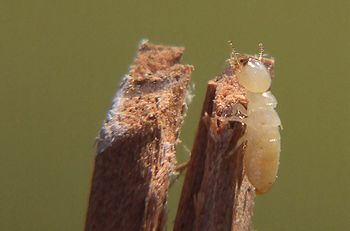
Xylophagy
Encyclopedia
- Not to be confused with XylophagiaXylophagiaXylophagia is a condition involving the consumption of wood. It is one form of the eating disorder known as pica. People who suffer from this eating disorder usually consume things like paper, pencils, tree bark or other items made of wood...
. See also wood-boring

Ecology
Ecology is the scientific study of the relations that living organisms have with respect to each other and their natural environment. Variables of interest to ecologists include the composition, distribution, amount , number, and changing states of organisms within and among ecosystems...
to describe the habits of an herbivorous animal whose diet consists primarily (often solely) of wood
Wood
Wood is a hard, fibrous tissue found in many trees. It has been used for hundreds of thousands of years for both fuel and as a construction material. It is an organic material, a natural composite of cellulose fibers embedded in a matrix of lignin which resists compression...
. The word derives from Greek
Greek language
Greek is an independent branch of the Indo-European family of languages. Native to the southern Balkans, it has the longest documented history of any Indo-European language, spanning 34 centuries of written records. Its writing system has been the Greek alphabet for the majority of its history;...
ξυλοφάγος (xulophagos) "eating wood", from ξύλον (xulon) "wood" and φαγεῖν (phagein) "to eat", an ancient Greek name for a kind of a worm-eating bird. Animals feeding only on dead wood are called sapro-xylophagous.
Xylophagous insects
Most such animals are arthropodArthropod
An arthropod is an invertebrate animal having an exoskeleton , a segmented body, and jointed appendages. Arthropods are members of the phylum Arthropoda , and include the insects, arachnids, crustaceans, and others...
s, primarily insect
Insect
Insects are a class of living creatures within the arthropods that have a chitinous exoskeleton, a three-part body , three pairs of jointed legs, compound eyes, and two antennae...
s of various kinds, in which the behavior is quite common, and found in many different orders
Order (biology)
In scientific classification used in biology, the order is# a taxonomic rank used in the classification of organisms. Other well-known ranks are life, domain, kingdom, phylum, class, family, genus, and species, with order fitting in between class and family...
. It is not uncommon for insects to specialize to various degrees; in some cases, they limit themselves to certain plant groups (a taxonomic
Taxonomy
Taxonomy is the science of identifying and naming species, and arranging them into a classification. The field of taxonomy, sometimes referred to as "biological taxonomy", revolves around the description and use of taxonomic units, known as taxa...
specialization), and in others, it is the physical characteristics of the wood itself (e.g., state of decay, hardness, whether the wood is alive or dead, or the choice of heartwood versus sapwood
Sapwood
Sapwood may refer to:* Sapwood, the part of living wood where sap flows, as distinct from the heartwood, where it doesn't* SS-6 Sapwood, the NATO reporting name for the R-7 Semyorka intercontinental ballistic missile...
versus bark
Bark
Bark is the outermost layers of stems and roots of woody plants. Plants with bark include trees, woody vines and shrubs. Bark refers to all the tissues outside of the vascular cambium and is a nontechnical term. It overlays the wood and consists of the inner bark and the outer bark. The inner...
).
Many xylophagous insects have symbiotic protozoa
Protozoa
Protozoa are a diverse group of single-cells eukaryotic organisms, many of which are motile. Throughout history, protozoa have been defined as single-cell protists with animal-like behavior, e.g., movement...
and/or bacteria
Bacteria
Bacteria are a large domain of prokaryotic microorganisms. Typically a few micrometres in length, bacteria have a wide range of shapes, ranging from spheres to rods and spirals...
in their digestive system which assist in the breakdown of cellulose
Cellulose
Cellulose is an organic compound with the formula , a polysaccharide consisting of a linear chain of several hundred to over ten thousand β linked D-glucose units....
, others (e.g., the termite
Termite
Termites are a group of eusocial insects that, until recently, were classified at the taxonomic rank of order Isoptera , but are now accepted as the epifamily Termitoidae, of the cockroach order Blattodea...
family Termitidae
Termitidae
Termitidae is a family of termite, containing the following subfamilies:*Apicotermitinae Grassé & Noirot, 1955*Foraminitermitinae Holmgren, 1912*Macrotermitinae Kemner, 1934*Nasutitermitinae Hare, 1937*Sphaerotermitinae Engel & Krishna, 2004...
) possess their own cellulase
Cellulase
400px|thumb|right|alt = Colored dice with checkered background|Ribbon representation of the Streptomyces lividans beta-1,4-endoglucanase catalytic domain - an example from the family 12 glycoside hydrolases...
. Others, especially among the groups feeding on decaying wood, apparently derive much of their nutrition from the digestion of various fungi that are growing amidst the wood fibers. Such insects often carry the spore
Spore
In biology, a spore is a reproductive structure that is adapted for dispersal and surviving for extended periods of time in unfavorable conditions. Spores form part of the life cycles of many bacteria, plants, algae, fungi and some protozoa. According to scientist Dr...
s of the fungi in special structures on their bodies (called "mycangia
Mycangium
The term mycangium is used in biology for special structures on the body of an animal that are adapted for the transport of symbiotic fungi . This is seen in many xylophagous insects , which apparently derive much of their nutrition from the digestion of various fungi that are growing amidst the...
"), and infect the host tree themselves when they are laying their eggs.
Examples of wood-eating animals
- Bark beetleBark beetleA bark beetle is one of approximately 220 genera with 6,000 species of beetles in the subfamily Scolytinae. Traditionally, this was considered a distinct family Scolytidae, but now it is understood that bark beetles are in fact very specialized members of the "true weevil" family...
s - Giant PandaGiant PandaThe giant panda, or panda is a bear native to central-western and south western China. It is easily recognized by its large, distinctive black patches around the eyes, over the ears, and across its round body. Though it belongs to the order Carnivora, the panda's diet is 99% bamboo...
- HorntailHorntailHorntail or wood wasp is the common name for any of the 100 non-social species of the family Siricidae, of the order Hymenoptera, a type of xylophagous sawfly...
s - Termites
- PanaquePanaqueThe genus Panaque contains a small number of small to medium sized South American armoured catfishes that are notable for being among the very few vertebrates that feed extensively on wood. In addition, algae and aufwuchs are an important part of the diet, and they use their rasping teeth to...
(catfish) - GribbleGribbleA gribble is any of about 56 species of marine isopod from the family Limnoriidae. They are mostly pale white and small crustaceans, although Limnoria stephenseni from subantarctic waters can reach .-Classification:...
s - ShipwormShipwormShipworms are not worms at all, but rather a group of unusual saltwater clams with very small shells, notorious for boring into wooden structures that are immersed in sea water, such as piers, docks and wooden ships...
s

